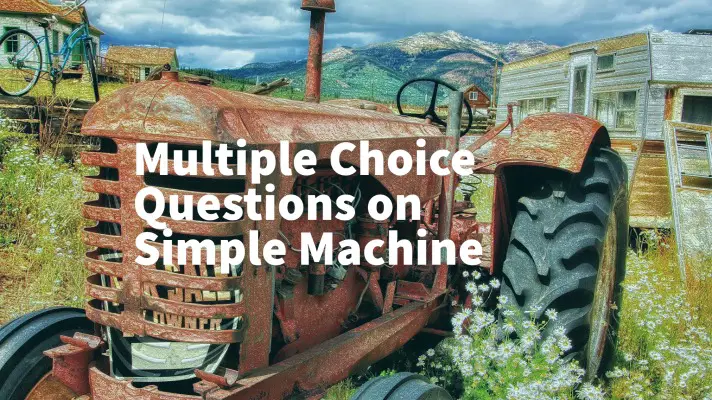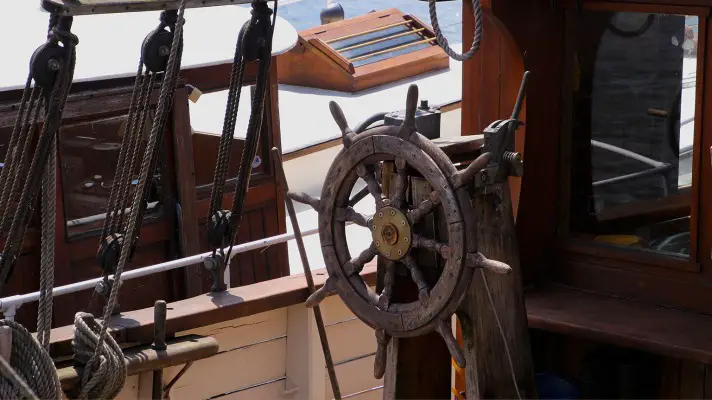In this article, you will learn about simple machines through some Multiple-Choice Questions. The different types of machines are Lever, Wheel, and Axle, Inclined Plane, Pulley, Wedge, and Screw. Here, you will get a lot of Objective Type Questions on Simple Machines.
There is also a quiz on Simple Machines. At the end of the article, by clicking on the PDF icon, you can download the MCQ sheet in PDF format.
Now, let us move into the MCQ Questions on Simple Machines:

MCQ on Simple Machines
- Fulcrum is the ______ of a lever
- fixed part ✔️
- moving part
- can’t say
- Lever consists of ______ parts
- two
- three ✔️
- four
- none of these
- Lever helps in ________.
- moving the objects
- lifting the objects
- all of the above ✔️
- Nail cutter is a ______________________class lever..
- first ✔️
- second
- third
- Lemon squeezer is a _______ class lever.
- first
- second ✔️
- third
- Scissors is a _________ class lever.
- first ✔️
- second
- third
- Stapler is a ______class lever.
- first
- second
- third ✔️
- Stair case is a / an ________________.
- lever
- inclined plane ✔️
- wheel and axle
- none of these
- In case of third class lever, the sequence is:
- effort, load, fulcrum
- fulcrum, load, effort
- fulcrum, effort, load ✔️
- load, fulcrum, effort
- In case of second class lever, the sequence is:
- fulcrum, load, effort ✔️
- fulcrum, effort, load
- load, fulcrum, effort
- In case of first class lever, the sequence is:
- fulcrum, load, effort
- fulcrum, effort, load
- load, fulcrum, effort ✔️
- Mechanical advantage is _______________.
- load / effort ✔️
- effort / load
- load + effort
- Efficiency of a simple machine is ______.
- effort applied on the machine / work done by the machine
- work done by the machine / effort applied on the machine ✔️
- none of these.
- Bottle openers is a __________________ lever.
- first class
- second class ✔️
- third class
For second class lever mechanical advantage is ____.
- always less than 1
- always greater than 1 ✔️
- always equal to 1
- Sewing machine is a ___machine.
- simple
- complex ✔️
- none of these.
Quiz on Simple Machines
Now, it is time for your quiz session:
The multiple-choice questions mentioned here are the basic questions from the chapter- “the simple machines” which will help the students of classes five and six.
You read the text first and then you appear for the quiz.
Overview
Simple machines are mechanical devices that perform a greater amount of work by using a single applied force. Moving parts may or may not be there.
In this case, we ignore friction losses. Work done by the applied force is equal to the work done on the load.
Lever- example of simple machines
A lever is a rigid rod. We use it to lift the weight. It moves freely around a fixed point. It consists of three parts- load, fulcrum, and effort.
Archimedes, a Greek scientist first discovered the laws of the lever. He discovered that a heavy load could be lifted easily using a lever.
Fulcrum
Fulcrum is a fixed part of a lever.
It is a balance point on which the rod moves.
Load
Load is an object which is to be lifted or moved.
Effort
The downward force that is applied on one end of the rod to move or lift the rod.
Lever helps us in moving or lifting heavy objects. For this, we have to apply a small force.
Depending on the position of the fulcrum, the load, and the effort, levers are classified into three types- first class, second class, and third class.
First class lever
In case of first class levers, the fulcrum is situated in between the effort and the load.
Examples:
- Nail cutters
- See saw
- Scissors
- Pliers
- Trolley
Second class lever
In second class levers, the load is in between the effort and fulcrum.
Example:
- Nutcracker
- Lemon Squeezer
- Wheel-barrows
- Bottle openers
Third class lever
In third class lever, the effort is in between the fulcrum and the load.
Examples:
- Stapler
- Fishing rods
- Ice tongs
Inclined Plane- a simple machine
An inclined plane is a sloping surface which is used to lift the things up. It requires less effort in lifting the things.
Example
Staircase, Needle
Wedge- a simple machine
The device by which we can change the direction of the input force is known as Wedge.
The wedges are moving inclined planes which are driven under loads.
Wheel and Axle- a simple machine
- The wheels were invented about 5000 years ago. They were made from solid planks of wood and were very heavy.
- Wheel and axle is a simple machine.
- It consists of a large wheel.
- This wheel is attached to a rod.
- The rod is called an axle.
- The wheel rotates in a circle around a center point. This is called a fulcrum.
- Example- Tyres in a car, bus, truck; pencil sharpener, doorknobs, giant wheel, etc.
Pulley- a simple machine

- It is a grooved wheel.
- It consists of a rope, chain, or belt running around it.
- A fixed rod is there around which the wheel rotates. This rod is called an axle.
- The axle passes through the center of the wheel.
- Two main types of pulleys are fixed pulley and movable pulley.
- It is also known as sheave or drum.
Fixed pulley
- Here, the pulley is fixed to a wall or to a hook.
- It changes the direction of the force but does not change the amount of force applied to it.
- Examples: Wells and flag poles.
Movable Pulley
- In this case, the pulley is not fixed and it moves along with the load.
- It reduces the effort required to pull a load.
- Examples: Cranes and tackle pulley in sailing boats.
Screw- a simple machine
- It is an inclined plane.
- The screw is wrapped around a rod spirally.
- Uses: to lift the materials, to hold the things together.
- Two things can be interlocked using a screw.
Mechanical Advantage of simple machines
Mechanical Advantage (M.A) is the ratio between load and effort.
M.A = (Load/Effort)
Smaller the effort required, greater is the mechanical advantage.
For the first class lever, mechanical advantage is not fixed. It may be equal to one, less than one, or greater than one.
For the second-class lever, the mechanical advantage is always greater than one and for the third-class lever, the mechanical advantage is less than one.
The efficiency of simple machines
The efficiency of a simple machine is the ratio between the work done by the machine to the effort given to the machine.
Efficiency = (Work done by the machine/ effort applied on the machine)= (Output/input)
In reality, the output can never be equal to the input as there are losses in all machines. Output is always less than the input. Hence, efficiency can never be one. But for an ideal machine where there is no loss, efficiency is one.
You may consider this as a test of 25 marks. After completion of the test, you can check the answers and can come to know how much you are prepared.
I hope that you will get interested in studying this topic “Simple machines”. Please feel free in writing to us if you want to appear for the MCQ test on other topics. Write the topic name in the comments box. We will come back soon with the new MCQ test as per your requirement. Thank you!



Thanks i am very good reading my school exam marks will 99*
I am very glad to hear this. Best Wishes!